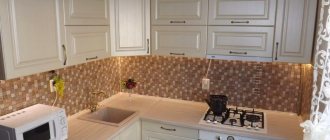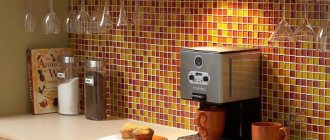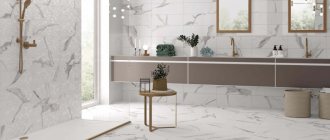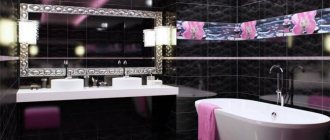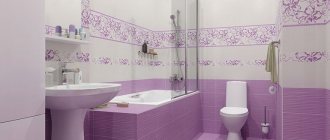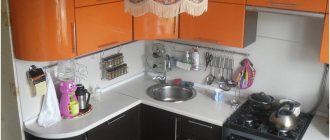SHARE ON SOCIAL NETWORKS
FacebookTwitterOkGoogle+PinterestVk
Toilet tiles are a common facing material that is practical, durable and durable. Rooms with high humidity require hygienic cleanliness, so it is difficult to choose a more suitable option than tiles. This article will discuss the main varieties of this material and tips on its selection and installation.
For rooms with high humidity, tiles are the most practical facing material
Pros and cons of using tiles in the toilet
First of all, it is necessary to note tiles as a material that is considered a priority on the market, as it has a long service life and looks very aesthetically pleasing.
If we talk about the advantages, then they are quite justified:
- The presence of a large assortment, which allows you to always make a choice, both in terms of cost and design;
- The floor, along with the walls, is leveled during such finishing;
- Caring for ceramic products is absolutely not difficult, and the color remains unchanged for a long time.
According to many, the disadvantages include:
- Labor intensity of work;
- The appearance of signs of mold and mildew over time;
The area will become noticeably smaller, about one or one and a half centimeters on each lined side.
The main criteria that play a role in the design of a bathroom
- Room area and ceiling height.
- Layout. The bathroom can be square, rectangular, or possibly L-shaped.
- General style of the apartment. It is desirable that the toilet does not stand out too much from the general style of the living space, but rather fits harmoniously into it. In an apartment with a classic renovation, designed in light colors, a bathroom decorated in flashy bright shades of modernity would not be appropriate.
- Presence of a window. If for small apartments this phenomenon is not frequent, then for private houses it is more likely the norm. The window makes the bathroom much lighter, which is important when choosing the color of the tiles.
- Functionality. Before renovation, you should decide in advance on the functional elements: shelves, bedside tables, hooks, towel racks, hand racks (for adjacent bathrooms), etc. Their number and location also plays a role in the design of the room.
Organic interior of a compact toilet with snow-white fixtures and black decorative tiles
With an integrated approach, and taking into account the above criteria, tiles for the bathroom will be selected in the shortest possible time and without any problems. It will fit perfectly into the interior of the toilet and will delight all household members.
Types of tiles for the bathroom
You can choose one of the following types of tile material for the toilet:
- Glazed fired clay or tiles, due to its good resistance to humid environments. In addition, both the different cost and aesthetically pleasing perception speak in its favor. The only thing is that it may crack over time;
- Porcelain stoneware products, which are distinguished by their durable structure, while creating the effect of the presence of natural stone or a wooden surface in the room. Such tile material does not absorb moisture at all, and also does not wear off over time. Excellent resistance to mechanical stress. It is better to choose non-slippery tiles for the toilet:
- Vintage quartz vinyl is justifiably considered premium class. An excellent combination of qualities such as ductility, along with wear resistance. Natural themes are the basis for the design of this tile material.
Options for laying tiles in the toilet
For floor coverings, it is acceptable to choose any of the three designated types. One of the trends in modern design is the proposal of specialists to lift floor tiles onto the walls, forming a single coherent space.
If we talk specifically about covering the floor surface, then maintenance should be as simple as possible, and slipping should be minimal. Besides:
- Checkerboard laying is the main type of laying:
- A combined eco-style bathroom is predominantly tiled with porcelain stoneware with a textured surface imitating pebbles or a wooden structure;
- In long and narrow toilets, you should not use a plinth for joining, otherwise the surface area will not become even smaller.
As for the walls, you need to choose light shades of tones to visually enlarge the space. In a combined bathroom, it is worth considering the purchase of material that can withstand jet streams of water.
As for the possibility of fungus formation, both porcelain stoneware and tiled tiles are resistant to this, and in practice, special grout is usually used for joint parts.
The niche can be lined with a contrasting color material or left in the same tone. Proper lighting will only add shine, reflecting from the glossy surface.
How to choose quality tiles?
To ensure that the purchased tiles are ideal for your bathroom and last a long time, you need to immediately pay attention to the following points:
- Plane. Every tile must be perfect. To test this, you simply need to stack two tiles on top of each other. There should be no gaps between them, but a difference of 1 mm is considered acceptable
- Diagonal. Each tile must be completely consistent with the others diagonally. To do this, use a tape measure. There should be no difference between the tiles at all; no deviations are allowed, otherwise the line will “move” when laying.
- Glaze. Even if you choose matte tiles, you need to check the quality of the top layer. To do this, look at the tile against the light: if there are cracks on the surface, it is not suitable for you.
Important! When choosing tiles from different collections, be sure to measure them and check the ratio of the diagonals. The same applies to decorative elements.
Design tips
To choose the right tiles for a small bathroom, you can seek the experience of famous designers. Here's what the professionals advise:
- To create a high ceiling, use vertical placement of elements, and place all decorative inserts at eye level
- Another way to visually stretch the space is to use borders not horizontally, but vertically
- If the room is narrow, use mosaics or other small elements in the decor
- Cool neutral colors are great for bathrooms
- In a small toilet, use a diagonal layout of floor tiles - this will visually expand the space
- When cladding narrow walls, use a horizontal orientation
Advice:
if the toilet space requires expansion both vertically and horizontally, combine options: use a diagonal layout on the floor and place small decorative elements at eye level.
Choosing the color of tiles for the toilet
For small rooms, professionals recommend using cladding materials in lighter colors, which will also make water stains less noticeable.
Desired colors:
- Snow-white, creating the effect of spaciousness, along with cleanliness. Thanks to different shades, an organic interior scheme can be achieved;
- Varying the gray color of platinum to agate allows you to use wooden fragments in decoration, as well as the texture of stone or concrete pavement. This corresponds to the loft trends, along with scandi and industrial.
- The black color follows the same loft style. The matte surface of porcelain stoneware looks expensive and at the same time stylish.
- The salad color of the leaves can always support a positive mood. Just don’t use only this shade so that it doesn’t eat up the volume. It is best to add a snow-white palette to it, gracefully emphasizing the green freshness.
- The choice of beige always looks good regardless of what surface is present - glossy or matte. With country house combinations, the bathroom will seem more spacious, and the organic color will not be disrupted.
When combining two to several colors, you can not only move away from the monotony of monotony, but also emphasize the originality of decorating the bathroom. When implementing a design idea, colored tiles appear next to neutral shades.
An unusual effect is created by cladding in red and white colors, and black will emphasize the expressiveness of yellow. The relevance of the black and white version always remains in force.
Color solutions
The color design of the bathroom depends on the stylistic decision and the area of the room. In the toilet of a Khrushchev apartment, which has an area of two to four square meters, tiles of the lightest, warmest colors are usually used. For rooms that are more spacious or have a window, it is possible to use any color solutions, including dark, cool shades.
The most popular combinations:
- golden with blue;
- hot pink with lavender;
- ocher with beige;
- brick with pale emerald;
- sunny yellow with brown;
- blue with canvas gray;
- turquoise with light green;
- black with milky white;
- lilac with fuchsia;
- vanilla with wine red;
- cloudy sky with olive.
When combining two or three colors at the same time, the main color should account for at least 60% of the total space. It is not recommended to use more than three colors.
Toilet tile design
In modern design, various options are used for cladding:
- A mosaic that completely changes visual perception;
- The structure of the wood species, which allows you to perfectly complement the eco-style;
- A patterned ornament or design, which has long been relevant for decorating toilet rooms;
- The room acquires status and an expensive appearance after finishing it with marble;
- The “hog” design allows you to maintain the stylistic direction of Scandinavia or loft, along with vintage design;
- Adding mirror surfaces that enhance the reflective lighting effect;
- Creating interesting combinatorics in order to enliven the room and make it more interesting.
Wood effect tiles
Previously, wood-look tiles were used in hallways and corridors, but now the fashion has reached toilet rooms. One of the most stylish, laconic techniques is to use the same type of tile on the back wall of the toilet and on the floor.
If you like dark colors, combine these tiles with gloss. It will add the necessary volume to the space. And it is not necessary to lay wood-effect tiles to the entire height of the wall - for practicality, a meter is enough. And above you can simply paint it.
Do you like niches or need to cover hatches in the wall? It’s cool when these areas are decorated with the same tiles. Yes, such work requires more skill. But believe me, the visual effect is worth it. In addition, if the master refuses to perform such work, it will be possible to draw a conclusion about his professional skills.
Although even metal doors can look great in a strict, seasoned interior. The main thing is that they cover the entire width of the wall and match the color of the rest of the interior. This way they won't attract too much unnecessary attention to themselves.
Recently, wood-look tiles with additional patterns have begun to appear. It looks quite fresh. But in this case, the rest of the interior should be minimalistic so that the eyes do not run wild in a confined space.
